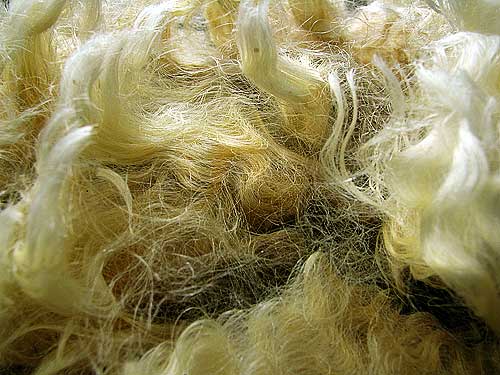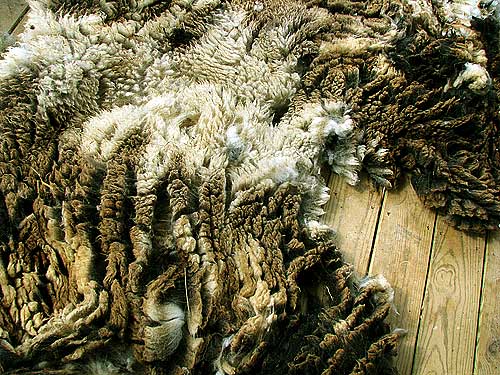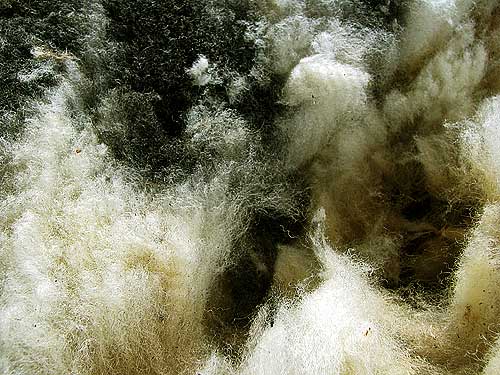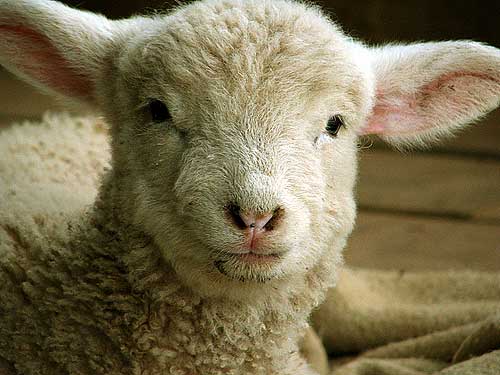Soft, rich, gorgeous Cotswold wool, fresh off the ewe.

Skirting a fleece is simply removing the debris (hay, straw, twigs) and cutting out matted parts. If your shearer does his job right, he’s cut away the belly wool while shearing. If not, cut away the belly wool now. (Our shearer did not cut away the belly wool, so we had to do it afterward. Lesson learned–sometimes shearers need instructions! In these parts, sheep raised for wool purposes are less common than sheep raised for meat. Shearers aren’t necessarily thinking about your use for the wool. They are, in fact, most likely only thinking about shearing the sheep.)
Jacob fleece.

Find a clean place to lay the fleece out. We used our back porch, which is gated off from the dogs and covered. After sweeping the porch clean, we laid each fleece, one a time, out on the floor to “skirt” it. (A special skirting table would be even better!) Lay the wool “inside” down, inside meaning the side of the wool that was next to the sheep’s skin. The inside is already clean. The “outside” is what needs skirting. The outside of wool is dirty–the sheep has been wearing it. The “inside” is amazingly clean and beautiful.
Incredible multi-colored Jacob wool, on the inside.

Once skirted (debris removed and matting cut away), with the fleece still “outside” on top, fold the fleece over, outside part against outside part. Now the pretty “inside” is out and you can roll the fleece up. (This process always keeps the dirtier “outside” separated from the clean inside and leaves the nice, clean inside out so you can see the lovely wool.
So, so pretty Cotswold wool.

For storage until further processing, place in breathable bags. We made bags out of cotton bedsheets and left the tops open for even more air.

The next step is washing! And drying, carding, spinning, knitting………..
Should I even try to do all that? I don’t know how. I just learned how to skirt out of a book. I could give all the wool to the birds. They need fodder for their spring nests, you know. Or I could see if anyone wants to buy the skirted, unprocessed wool. And maybe keep one fleece for myself….. To practice on and learn to do all the rest! Life is a bold adventure, right?
Annabelle: “Go for it, maa-maa.”

I just love her!


ulli says:
Love the last picture! Adorable :sheep: Just a word on getting the fleece clean… I don’t know anything about it other than from a consumer’s viewpoint. I purchased some yarn from Peace Fleece–a company out of VT run by some aging hippies (their words, not mine) who get their yarn from some of the poorer areas of the world including the US to help these people make a living. It’s an interesting story. I was excited about getting my yarn (which came from Appalachia by the way), but when it arrived and I started knitting I wasn’t so happy. As I knit the sweater for my hubby, I had to pull dirt, dry grass, straw, etc. out of it. They didn’t clean it well and it was a big pain in the you know what. When I emailed them to ask about it they replied it was acceptable to have a certain amount of “veg” in the finished product. Their yarn is known as rustic yarn–and it is. Personally I don’t think it’s acceptable at all and I won’t purchase from them again. The time it took for me to pull out fairly large pieces of veg took a lot longer to complete the project and made it a frustrating knit–no fun at all. …just my thoughts…
I would love to purchase some nice clean yarn from your sheep, Suzanne. Keep us posted on the progress if that is what you plan on doing with it.
On March 1, 2009 at 6:50 am
Senta says:
Just a question? But doesn’t carding and spinning take out a lot os the veg? :sheepjump:
On March 1, 2009 at 5:51 pm
Grace Gooding says:
ulli–not to be a (well, I don’t know), but it is my impression that if you are buying yarn that DOESN’T have any vm in it, either the sheep wear little jackets OR the wool is processed with chemicals that actually eat up/break down all of the little bits of plants. Cestari yarn also has little bits of vm in it. I haven’t bought any Peace Fleece because I am cheap, but, I thought that was something you might want to know.
grace 🙂
On March 7, 2009 at 9:37 pm
margiesbooboo says:
Morning Suzanne,
Have you spoken to the folks at paintedrockfarm.com ? They have Jacob sheep and they’re in Buckhannon. I know its a little ways from you but they may be able to point you in the right direction for help with the wool. The best, already paid for advice for you is the local county extension agent. They should tell you who, what where and when of sheep herding. Those people will even come out to the farm if its needed. I saw some videos on youtube about shearing sheep, Jacobs and Cotswold. Apparently, there is a doll on the market that teaches you the path to cut when you shear the wool. Good luck with the wool.
How’s the injured animals?
huggs,
margiesbooboo
On March 1, 2009 at 7:15 am
Diane says:
You got lots of wool. Its good that you keep it clean. See if you have a local 4h club that teaches spinning and knitting. They might be intrested in purchasesing your wool for projects for the kids. They might even like the dirty wool in order for the kids to learn how to clean the wool and get it to the point where they can spin it then knit it into a wearable item.
You can learn to spin the wool. That is something I would love to learn. But a spinning wheel is way out of my price range. But its neat to watch people spin that wool.
What an exciting adverter you are on with the sheep. Thanks for shareing it with us.
On March 1, 2009 at 7:49 am
Fencepost says:
I would sell most of it, but would have to keep some for practice and some in memory of the first sheep shear on the farm.
I love that last picture. Her little nose is adorable. I have a thing for critter noses. Its something I collect on my blog.
On March 1, 2009 at 7:51 am
shirley says:
Annabelle, tell your mommy that you intend to remain a pampered little lamb and NOT part of the herd!
Demand to be taken to the groomer regularly for haircuts and pedicures.
And last but not least, demand a tiara! If Clover is the Goat Queen, then you should be Sheep Queen.
Come to think of it, a Princess tiara would do for now, Princess Annabelle!
Now doesn’t that have a nice ring to it?
signed……Your loyal subject, Shirley
On March 1, 2009 at 8:08 am
LauraP says:
Now that you have all that wool, you need to find a sheep/wool festival. They’re everywhere in spring & summer. Fiber folks are the most generous, welcoming people, and you’ll find people there willing to teach you anything you need to know about properly washing, sorting, carding, combing, spinning, weaving and knitting that wool. Plus how to grade the wool’s quality and judge the health of the sheep by the condition of the wool. And, even how to turn the nastiest dirty, matted, tangled belly wool into incredibly beautiful yarn.
P.S. Every shearer I’ve ever known concentrates on getting the wool off the sheep quickly, with minimal trauma to the sheep, and without having to make second cuts in the wool. (Which leaves you with short bits that make noils or pills in the yarn if you don’t get them all picked out.) Skirting is a post-shearing job, and I don’t want to pay the shearer for the extra time for something I’d rather do myself because nobody does it the way I like it better than me.
On March 1, 2009 at 8:08 am
Brenny Seader says:
If you go to interweave.com, click on the “Spinoff” area, you will find a how to spin instruction area. You can use a drop spindle, instructions for one made of a dowel, a cup hook and an old cd are given there as well. I find spinning to be very relaxing, and a drop spindle (one of the earliest forms of spinning with a tool) is easily portable.
You can also find many good sites with instructions on how to wash your wool-in a nutshell, I separate batches of wool from the fleece (not breaking up the lock structure), place them in a laundry bag, and soak in Dawn in the bathtub, never agitating or running water directly on them. After cleaning, you can brush each lock to separate the fiber, then spin it. This is a very short description of the process, only to give you some idea of what is involved. You can get a lot more information by finding a store in your area, or a wool market event, and ask someone to show you–most spinners are happy to demonstrate!
Just discovered your blog, and love it. I will try your bread conditioner soon!
Brenny
On March 1, 2009 at 8:50 am
Linda says:
I’m sure you won’t have trouble getting rid of your wool. But you need to keep at least one so we can all learn how it is done.LOL
On March 1, 2009 at 8:59 am
Nancy in Atlanta says:
That wool – from both types of sheep – is gorgeous! I had to run my hands through my cat’s fur just to pretend she was a sheep while I looked at the photos! I’m so envious of you and the other sheep farm bloggers – I’ve never felt wool right off the sheep. Must be marvelous.
Princess Annabelle – I like that! :sheep:
On March 1, 2009 at 9:28 am
Claudia W. says:
This all looks like so much fun/work! A labor of love. I can’t wait to see what the next step is in this process. Not that I would ever get a chance to do any of it, but I like to see how things are done right from the beginning. It makes me understand what I am crocheting/knitting with. The wool is gorgeous! You are so adventurous!
On March 1, 2009 at 10:00 am
Gail says:
Suzanne, I love these posts. I am learning so much from your adventures! I didn’t know anything about sheep, but now I do know a few things! LOL!
I think you should sell some of the wool and get a bit of money to put towards your spinning wheel. You’ve got to try the spinning and knitting! I agree that “Princess Annabelle” should not be considered part of the herd. She’s too spoiled and cute!
On March 1, 2009 at 10:22 am
Carol says:
Carding, spinning, knitting – learn it all! Life is a bold adventure and you and your little farm are living proof!
On March 1, 2009 at 10:23 am
catslady says:
Oh I thought there was a spinning wheel at the old farm house but maybe that was the loom I was thinking of. Maybe you could make it a winter project when there aren’t a thousand things going on! :sheep:
On March 1, 2009 at 10:51 am
Suzanne McMinn says:
There is a spinning wheel at the old farmhouse. It’s an antique, so I’m not sure either that they’d let me use it or that it’s even functional!
On March 1, 2009 at 10:55 am
tillie says:
clover, come home.
On March 1, 2009 at 11:05 am
Leah says:
WOW! You did it! Sounds like a good idea to learn on one fleece. Or maybe someone who wants it could show you how to process it in return. I still love Annabelle too! :snuggle:
On March 1, 2009 at 1:10 pm
Susan says:
I agree with Annabelle…go for it! :happyflower:
On March 1, 2009 at 1:22 pm
annbb/TSannie says:
Wow! Didn’t have the slightest idea all that goes into make wool…wool!
And that little lamb is just adorable.
On March 1, 2009 at 2:36 pm
kacey says:
That’s a lot of fleece. It is a lot of work to clean it and get it ready to spin. But I have no doubt that if you decide to become a spinner, you’ll conquer it!
On March 1, 2009 at 2:46 pm
Brandy says:
Annabelle is adorable! As for the wool, maybe you could find some spinners willing to teach you in exchange for some wool.
On March 1, 2009 at 2:48 pm
Estella says:
Annabelle is adorable!
When you learn how to clean card and spin wool into yarn maybe you can show us how?
On March 1, 2009 at 3:00 pm
Molly says:
I would totally buy one of the fleeces!
On March 1, 2009 at 3:30 pm
Nannette Saunders says:
Suzanne I love Annabelle easy to see why you fell in love with her. What an adventure and quite inspiring. Best of luck to you!
On March 1, 2009 at 5:33 pm
IowaCowgirl says:
All right Suzanne,
Come to Iowa, give this woman (Margie) a call and she will educate you. If you can’t come to Iowa, she will probably know a buyer for your lovely wool!
Tipperary Farm and Fiber Studio
Pat/Margie Meehan
2857 Hwy. 38
Hopkington, IA 52237
(563) 926-2573
[email protected]
On March 1, 2009 at 6:16 pm
Sarah S. says:
:sheep: I just love your Annabelle pictures she has the sweetest face!
https://sprucehill.typepad.com/
On March 1, 2009 at 7:39 pm
amy says:
I am a spinner 🙂 The wool shots are divine and make my hands itch with want. Find someone local who will teach you to use your wool (spin, knit, weave) in exchange for some. You just have to TRY it!
On March 1, 2009 at 8:42 pm
Laurie says:
I just found your blog…I’ve visited my local sheep farm to get some wool, your wool is beautiful!!! Laurie
On March 1, 2009 at 9:18 pm
Ellen says:
one of the really wonderful things about wool fleece is that indescribable lanolin smell and feel.
On March 1, 2009 at 9:46 pm
Dawn says:
You should learn to card and spin and knit and weave and…in-between feeding animals, gathering eggs, raising kids, and writing. :)Just discovered your blog and am enjoying it.
On March 1, 2009 at 9:52 pm
Wendy says:
Suzanne,
You are a bad influence on me. All those pictures of Annabelle did me in. Come over to my blog and check out what you made me do.
Goatgirl aka lamb-lass
On March 1, 2009 at 11:03 pm
Lynn says:
This is probably a pretty naive question, but please keep in mind I know nothing about farm animals! If the sheep are pets (surely you are not going to eat them right?), can they be groomed on a regular basis to keep a short clean manageable coat like Annabelle’s baby coat?
On March 2, 2009 at 3:43 pm
Lauri says:
How could you not LOVE that little face? I could just stare at her all day!
On March 3, 2009 at 7:48 am
tabbimama says:
I want to kiss Annabelle’s whole face and cuddle her in my arms and listen to her bah. She is too cute!
On March 4, 2009 at 12:28 am
Grace Gooding says:
Dear Suzanne–
Saw you on Ravelry (I’m goodnessgracious and I don’t post much, but lurk on the WV fiber craft whatever and some other forums) and followed you here.
Does everyone shear now? I’m wondering about my local friends who raise sheep for meat…
Anyhow, what sort of fleeces do you have and do you really want to sell some of them? I am not all that experienced (but getting more so, lol–mostly I buy a pound here and there) at processing wool, but I would hate for you to have yummy fleece just taking up space at your house! lol… I have most of a Coopworth fleece already (mine was got for me by a friend in Maine last summer), but I’m always interested in trying something new, at the right price.
I’m in Huntington.
🙂 grace
On March 7, 2009 at 9:31 pm